Hrubieszów 2021-10-29
Krakow Główny - Hrubieszów night passenger train. 1960 - 1970.
Passenger cars in Poland.
After the end of World War II, the Polish State Railways had about 6,500 passenger carriages. However, the number of active wagons was smaller and amounted to only 3,500 wagons. These were mainly two-axle and three-axle passenger carriages. Many of these wagons were of wooden construction. The capacity of these wagons was small in relation to the transport needs. Therefore, roofed freight cars, temporarily adapted to passenger transport, as Class 4, were often added to passenger trains.
What about the other passenger cars? After all, there were about 3,000 copies. Some of them were really out of order and showed signs of war damage. However, many of them were simply stolen. According to post-war agreements, these wagons were to return to Poland. Especially the Germans left us obsolete carriages that still remembered the Great World War, and they took modern Polish carriages built in Poznań (HCP), Warsaw (Lilpop, Rau and Loewestein) and Sanok (United Fabryka Maszyn, Kotłów i Wagonów - Ludwik Zieleniewski and Fitzner- Gamper SA). They explained that they had left a modern Maschienenbauanstalt Breslau factory (Machine Building Plant) in Wrocław. In fact, the plant was 80% destroyed, and the rest of the machines were removed by the Russians. In order for the plant to be able to produce, it was necessary to build production halls from scratch and purchase machines.
The Russians were the second nation to openly rob Poland of its railway property. Carriages and steam locomotives went to the East. The following were taken away: railway tracks, sleepers, switches, semaphores, and even an electric traction built by the Germans in Lower Silesia. After the death of Joseph Stalin, the Russians willingly began talks about the regulation of the railway exchange. For example, a Polish passenger paid 31 zlotys and 85 groszy for 100 km of rail travel. And Russia paid only 2 zlotys 95 grosz for its citizen (usually a soldier) in Poland. There was only one taboo topic: The theft of railway property from Poland in the period 1944-1945. Other matters were discussed. The Russians agreed with the assessment of the Polish side, but spread their hands and said that it was beyond their capabilities. At the highest level, in the Kremlin, the Russians blackmailed us. They said - "The liberation of Poland cost the CCCP 35 trillion rubles, so they will not deal with small amounts."
Let us return to the modern wagons produced in Poland in the 1930s. We mean passenger carriages on two bogies. The first two-bogie passenger carriages were developed in the USA in the 19th century. The advantage of these wagons turned out to be greater availability while traveling than wagons with only two axles. Thanks to the four support points for the wagon, the wagon's longitudinal sway is almost completely gone. These types of wagons have been significantly lengthened. Their length of about 25.00 m far exceeds the so far typical length of about 14.00 m.
Lilpop, Rau and Loewenstein.
The company Lilpop, Rau and Loewenstein operated in the period from 1866 to 1944. The plant was the largest in interwar Warsaw. The factory offered a wide range of manufactured devices. The following were produced: locomotives, rails, railway carriages, motor carriages, tram carriages, cars, bus bodies, water supply devices, agricultural machines, truck chassis, internal combustion engines, steam engines, water turbines, firefighting equipment, laundry machines, bridge elements and others. The factory also realized orders for the Polish Army.
The production of carriages and rails in the "Foundry and Government Machin Factory" in Solec started in 1855. The plant became part of the Lilpop, Rau and Loewenstein companies. At that time, an order was being carried out for the newly emerging Warsaw-Vienna Railway (former spelling). In the period 1882–1886, the company bought several small factories in Russia and dominated the Russian railroad market there. On April 1, 1879, the concern produced the first steel rail. Until now, iron rails have been produced. Steel wheel rims also began to be made.
After the Great World War, the production of wagons was resumed, thanks to loans obtained in the USA. The range of products was increased and the employment was increased to 3,500 employees. After the German army invaded Poland, the plants were taken over by the occupant and included in the Hermann Göring Werke concern. Until the end of 1941, the plants produced coal wagons and repaired steam locomotives and wagons for the eastern front. The Lilpop, Rau and Loewenstein concern was liquidated in 1944. In August 1944, all machines, devices, documentation and Polish specialists were transported to Germany. Factory buildings were blown up and completely destroyed. The value of the lost property amounted to PLN 384.7 million pre-war (according to the value from 1939).
Passenger car No. 05 701 Bhuxz, was built in 1939 at the Lilpop, Rau and Loewenstein Works in Warsaw and is a representative of a very modern series of A-VIII type carriages, steel structure. Electric welding was used in the construction of these wagons. Wagons of this type were characterized by a very comfortable and elegant interior finish. The car has 8 compartments with 8 seats on soft sofas. Due to the narrowing of the body at the ends of the wagons, which was used to improve aerodynamics, these wagons were called "Pike". The wagons of this series were intended to service the most prestigious trains in the pre-war and post-war period, until the mid-60s. These wagons were part of pre-war tourist trains.


Details of T-T passenger car No. 05 701 series Bhuxz:
Producer of Lilpop, Rau and Loewenstein in Warsaw. 1939 year of construction. Number of axles 4. Two rolling carriages. Overall length 22.02 m. Bogie spacing 14.60 m. Number of seats 64. Design speed 80 km / h. Steam heating. The wagon is in the Chabówka open-air museum.
United Factories of Machines, Boilers and Wagons - Ludwik Zieleniewski and Fitzner-Gamper S.A.
United Factories of Machines, Boilers and Wagons - Ludwik Zieleniewski and Fitzner-Gamper S.A. it was the largest concern in the machine industry in the Second Republic of Poland with its headquarters in Kraków. The beginnings of the concern date back to 1804, when the forge of Mr. Paweł Nowakowski was established, which was taken over by Mr. Antoni Zieleniewski in 1810. The father's work was continued by his son Ludwik Zieleniewski. The concern had plants in Kraków, Sosnowiec, Sanok, Lviv and other cities of the Imperial-Royal Austro-Hungarian Empire. Individual factories built machines for various industries: steam boilers, cisterns, pipes, refrigerators, iron structures, bridges, ships, car bodies and railway carriages.
We are interested in the production of railway carriages. The factory that produced freight wagons was the Wagon and Machine Factory in Sanok - Kazimierz Lipiński (1887–1894), which was then transformed into the First Galician Wagon and Machine Construction Joint Stock Society (1895–1913). In Posada Olchowska near Sanok, in the period 1894–1897, new factory halls were built and the production of freight and passenger railway carriages, as well as trams started. Even before the end of the 19th century, the company had become a leading and one of the largest manufacturers of rail vehicles in the Imperial-Royal Austro-Hungarian Empire.
Already in the first period, he built the factory; 50 copies of tram cars for Vienna, 30 copies of horse tram cars for Ostrava, 50 copies of passenger carriages of the 3rd class for the state railways in Romania. On special orders, saloon and funeral carriages were also built. At the beginning of the 20th century, a series of motor and trailer trams was built for Krakow. Then, the Polish Machines and Carriages Factories - Ludwik Zieleniewski in Kraków, Lviv and Sanok S.A., Fabryka Sanocka (1913–1928) operated. The factory mainly produced wagons and trams. During the Great World War, the plant was destroyed by the Russians. Production was resumed in 1920. At that time, the Polish government ordered eight thousand freight cars and two thousand passenger cars within 10 years. In 1923, record production was achieved. 1,395 freight cars and 60 passenger cars were built. Orders were also carried out for foreign countries, such as electric trams for Ostrava. In total, by 1925, the factory had produced 15,700 wagons of all types, including 4,800 for PKP. From 1928, the factory carried out a long-term contract for wagons for PKP. However, the world crisis did not spare the factories in Sanok, which lasted here in the period 1930 - 1934. Orders decreased rapidly and workers were laid off. Out of 1,700 employees, around 200 remained. From 1934, railway carriages for PKP were built again in Sanok. In 1935, the production of passenger motor cars was launched. In total, during the Second Polish Republic, the plant produced 8,500 railway and 200 tram carriages. In addition, carriages and trams were repaired.
During the German occupation, production was carried out for the needs of the German army. After the Second World War, initially small metal elements were manufactured for the needs of the next occupier, this time Russian. Among other things, nails for rails were produced. Then, PKWN ordered the repairs of trams for Warsaw and the production of freight cars. In 1945, the factory was nationalized. On November 6, 1946, the hundredth post-war coal wagon was built. In 1948, the plant was named Sanocka Fabryka Wagonów "Sanowag". The production of freight wagons decreased until in 1957 it was completely stopped. The plant has specialized in the production of buses.
Hipolit Cegielski's plant in Poznań.
The Hipolit Cegielski Works in Poznań produced freight cars from 1922. In 1928, the plant started the production of 4-axle passenger carriages with a metal box. The first PKP wagon was delivered in November 1928. The wagon was designated Chxz and was a 3rd Class wagon. In 1928, the plant in Poznań built 5 Gmx series postal wagons. In the period 1928-1939, Zakłady Hipolit Cegielski built 70 passenger carriages of 3 classes of the Chxz series for PKP. At the same time, in the period 1930 - 1938, the plant built 130 passenger carriages of the 3rd class of the Churz series. In 1936, 34 electric control and trailer carriages of the EMU system for the Warsaw railway junction were built in Poznań.
Passenger and tourist carriages had 80 seats in 10 compartments and 9 seats unfolded in the corridors. The curb weight of the passenger car was 45,000 kg, and the tourist car was 47,350 kg. The length of the poodle of both types of wagons was 20.72 m, the spacing between the pivots of the bogies was 14.6 m, and the wheelbase of the bogies was 2.15 m.
In the period 1931 - 1939, the Hipolit Cegielski Works also produced motor carriages for PKP. Initially with a Clayton steam drive, then a combustion engine.
Hipolit Cegielski's works after the Second World War.
After the Second World War, the production of passenger carriages in Poznań resumed in 1946, on the hundredth anniversary of the establishment of the Hipolit Cegielski Works. At that time, 2 compartment coaches, 3 Classes, type 23W of the Chxz series, with fully welded boxes, with a weight of 35,000 kg, were built. The design and construction of 23W wagons was undertaken by the plant on its own initiative. It was the first Polish independent construction of a 4-axle passenger car after the Second World War. In November 1945, the Wagon Design Department of the Ministry of Transport presented to the Technical Council at the Ministry of Communication the design assumptions of the new, four-axle, 3rd Class car. The technical design was developed by the Central Design Office at the Union of Rolling Stock and Railway Equipment Industry, marked with the symbol type 23W. Government support in Warsaw was obtained and in the period 1946 - 1950, 486 passenger carriages, 3 Class, type 23W, Chxz series, were built. The wagons were popularly called "Tapers" due to the endings of the boxes. Wagons of type 23W were renamed to type 1A.
The structure of the 23W railroad car refuge was used in the construction of sleeping cars type 11A, 12A and 13A, of which the Hipolit Cegielski Plant produced 25 for PKP in the period 1948 - 1950. Sleeping carriages type 11A, 12A and 13A were more couchettes than sleeping cars. The wagons were derived from the 23W type construction. These were carriages built on a metal support and with a metal box. Steel was used and joined by welding. The boxes were clad with sheet metal and riveted to the box's lattice. The interior of the wagon is finished with wood. The doors to 9 compartments were wooden. The seats were of wooden construction with thin upholstery, covered with smooth green or blue leather. There were 6 fold-out sleeping places in each compartment. The bottom bunk was a seat for travelers during the day. The others were high backs that had to be raised, locked on folding catches and attached to two webbing straps with hooks in the ceiling. The belts supported the sleeping place and prevented the passenger from falling. There was a table, dustpan and ashtrays in the compartment. The table was propped up by legs. There was a sidewalk on the floor. The windows in the car were single-piece and opened by lowering them down. Additionally, there was a balustrade in the window made of one tube at a height of about 0.40 m from the bottom of the window. The lighting of the car was white lamps with convex, round lampshades concealing one or two bulbs. The light switch was located above the compartment door. The curtains on the windows were green and relatively thick, letting little light in. There was a sidewalk on the floor. The car was heated by steam, powered by a steam locomotive or a diesel locomotive equipped with a heating boiler.
Type 11A, 12A and 13A wagons ran on long-distance and night routes, such as the Kraków - Tarnów - Rzeszów - Stalowa Wola - Zwierzyniec - Zamość - Hrubieszów route. The train from Krakow left at 20:00 and at 07:00 was in Hrubieszów.
In 1954, a prototype of the 14A sleeping car was built, the serial production of which was taken over by the PaFaWag Wagon Factory. The plant in Poznań had the problem that there was no upholstery department there. Therefore, passenger carriages were produced with hard, wooden seats. The Polish government decided to transfer part of the production to PaFaWag in Wrocław.
State Wagon Factory in Wrocław.
Then, in Poznań, work began on the design of a wagon with soft seats and compartments, the then 1st and 2nd Class 56W (later 3A). As there was no upholstery department in HCP, it was decided to transfer the production of wagons to PaFaWag in Wrocław. Compared to the 23W (1A) wagon, the 56W (3A) wagon had eight compartments instead of nine, with the same body length. In addition, there were only 6 seats in the compartment, instead of 8. This provided a much more comfortable travel. The production of these wagons started in 1950.
Earlier, in the period 1948 - 1949, PaFaWag had built 66 postal wagons modeled on 23W wagons. In 1949, PaFaWag built a restaurant car prototype. Another modified passenger carriages produced in Wrocław were designated 4A, 5A, 6A and 7A.
Type 5A wagons were 2/3 Class passenger cars. There were four "soft" and four "hard" compartments in the car. A total of 50 copies were built.
By 1956, PaFaWag had built 685 passenger carriages that met the most urgent needs of the Polish State Railways. In 1956, the classes of cars were changed. The 1st Class, which was targeted at international transport, has been eliminated. Unfortunately, Poland was surrounded by enemies, so the international movement did not develop as expected. 2nd Class became 1st Class and 3rd Class became 2nd Class. Except, the 2nd Class already had wagons with soft seats. The "hard" wagons were left for local routes, with little passenger traffic, where pre-war wagons still ran. Hard wagons were operated until the end of the 60-year period and sporadically in the first half of the 70-year period. In the case of type 7A wagons, the Bhuxzt series mark was changed to Ahuxzt.
In 1959, the Polish State Railways had about 2,500 post-war wagons: passenger, restaurant, postal, luggage and service cars. About 200 wagons were exported. Luggage wagons were built until 1964.
From 1960, 1st Class carriages, constructed in 1946, underwent numerous modernizations. Individual seats were fitted. Heating changed from steam to electric. The interior design was changed. Sometimes new rolling bogies were installed, which allowed the train to run at a speed of 140 km / h. Tests of the type 7A passenger car with new bogies have shown that the car is still stable on the tracks up to a speed of 188 km / h. The electric locomotive could not go any faster. In 70 years, the remaining 7A carriages were reclassified to 2nd class carriages.
In the 60s and 70s, the carriages of type 7A (and derivatives) were used to compile uniform trainsets with passenger cars, postal cars, luggage cars, bar cars and sleeping cars (couches). These were express, fast, fast and long-distance trains. These wagons were replaced by the "Y" type wagons.
Saloon car No. 07 Ashx series.
The saloon car No. 07 of the Ashx series was built on the basis of a type 7A car. The salon, located in the collection of the Chabówka open-air museum, was built at PaFaWag in 1958. Inside there is a conference room, a TV lounge, a fully equipped kitchen (fridge, washbasin, gas cooker), bathroom, compartments with six sleeping places. The car has an electrical installation of 230 V. Steam heating is standard. There is also heating with a stove during long stops. The wagon is 23.30 m long. The distance between the turning pins is 16.00. Design speed 80 km / h.
In addition, the wagon is equipped with an electrical installation for 230V and individual heating, which ensures the supply of heat also during a long stopover of the wagon.
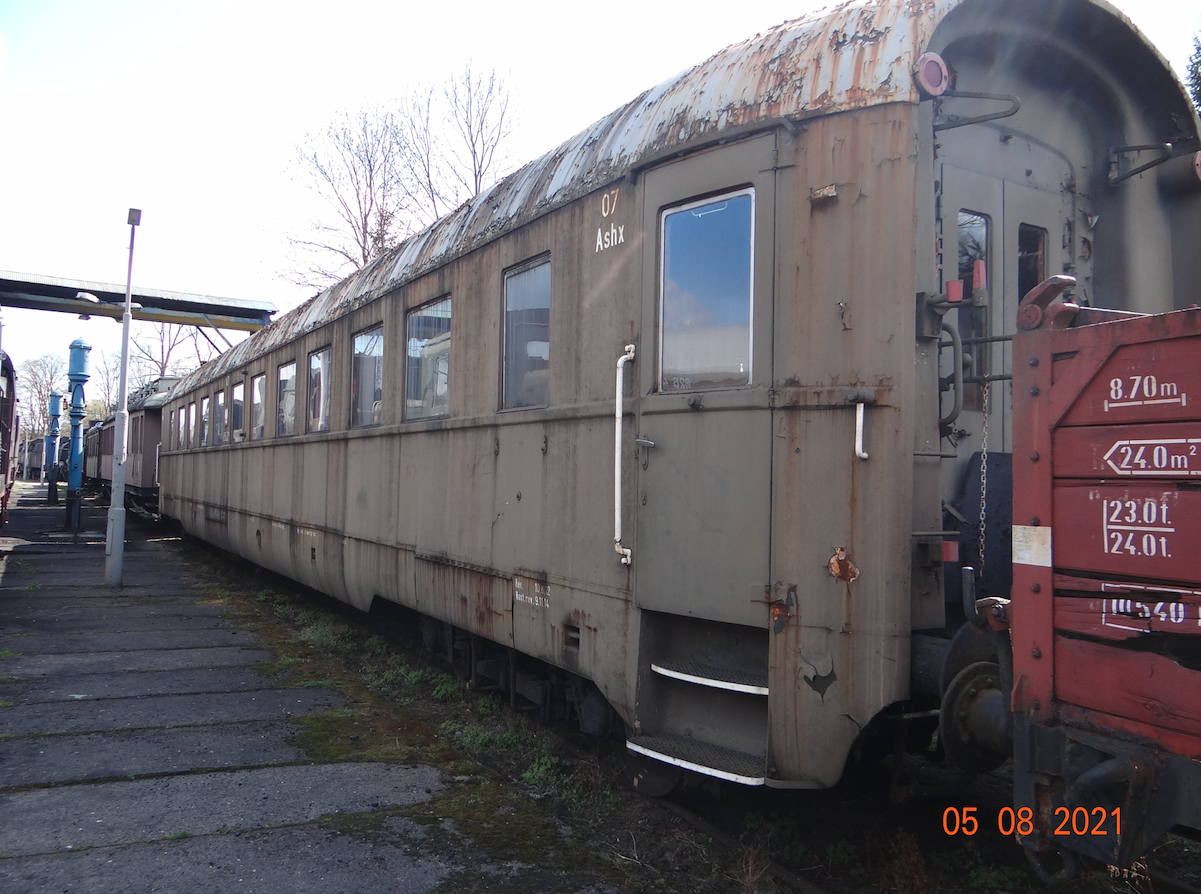
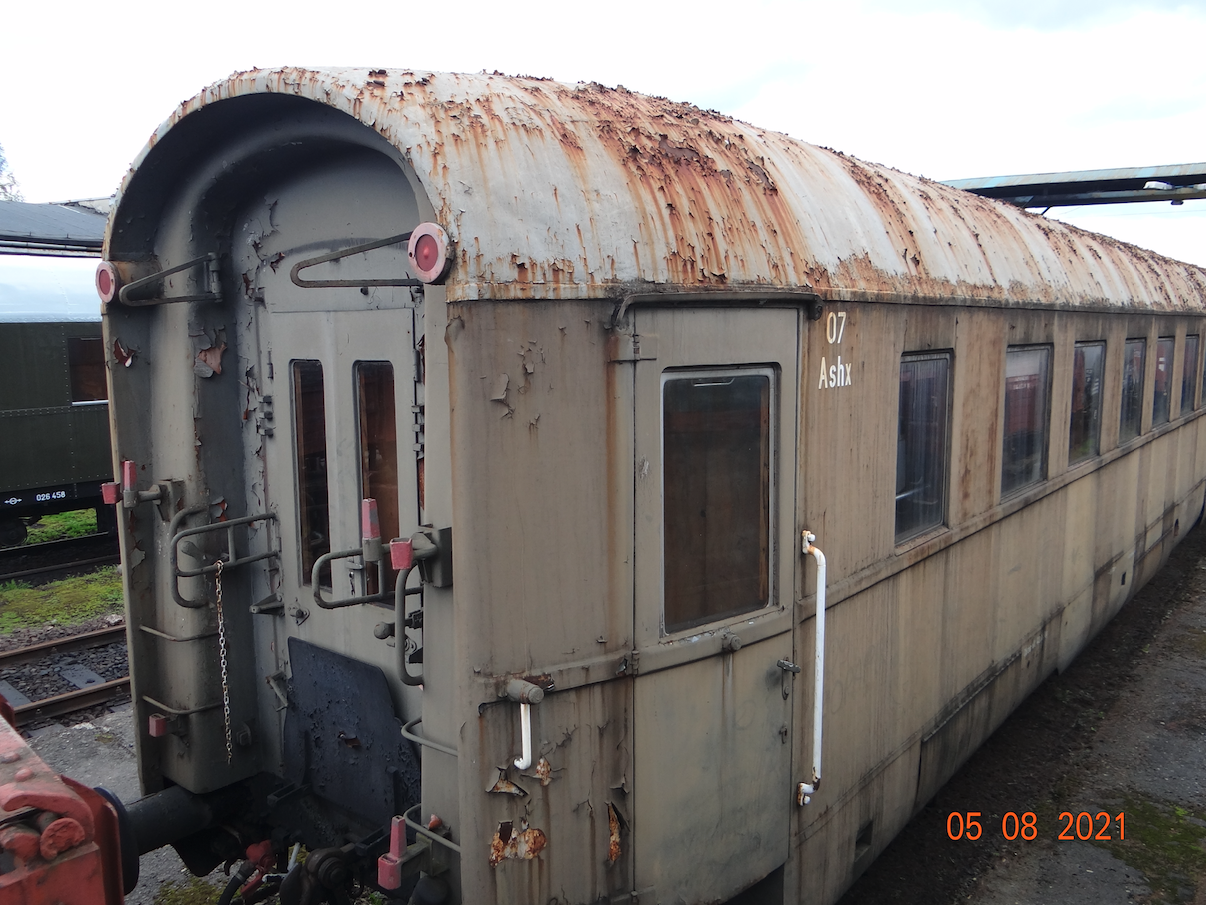
Postal wagon nr 040 314 Gmhx.
The postal car No. 040 314 Gmhx is located in the Chabówa open-air museum. It was a typical rail car designed for the transport of postal items. The interior of the wagon was divided into a warehouse and an office, where postal workers (ambulances) sorted letters and parcels. The wagon served the starting and end stations as well as all intermediate stations along the route. The wagon is a four-axle German-built wagon, built in 1930. Producer Niesky. At the end of the service, the wagon was converted into a bar wagon. For the Chabówka open-air museum, the wagon was renovated at the ZNTK in Ostrów Wielkopolski.
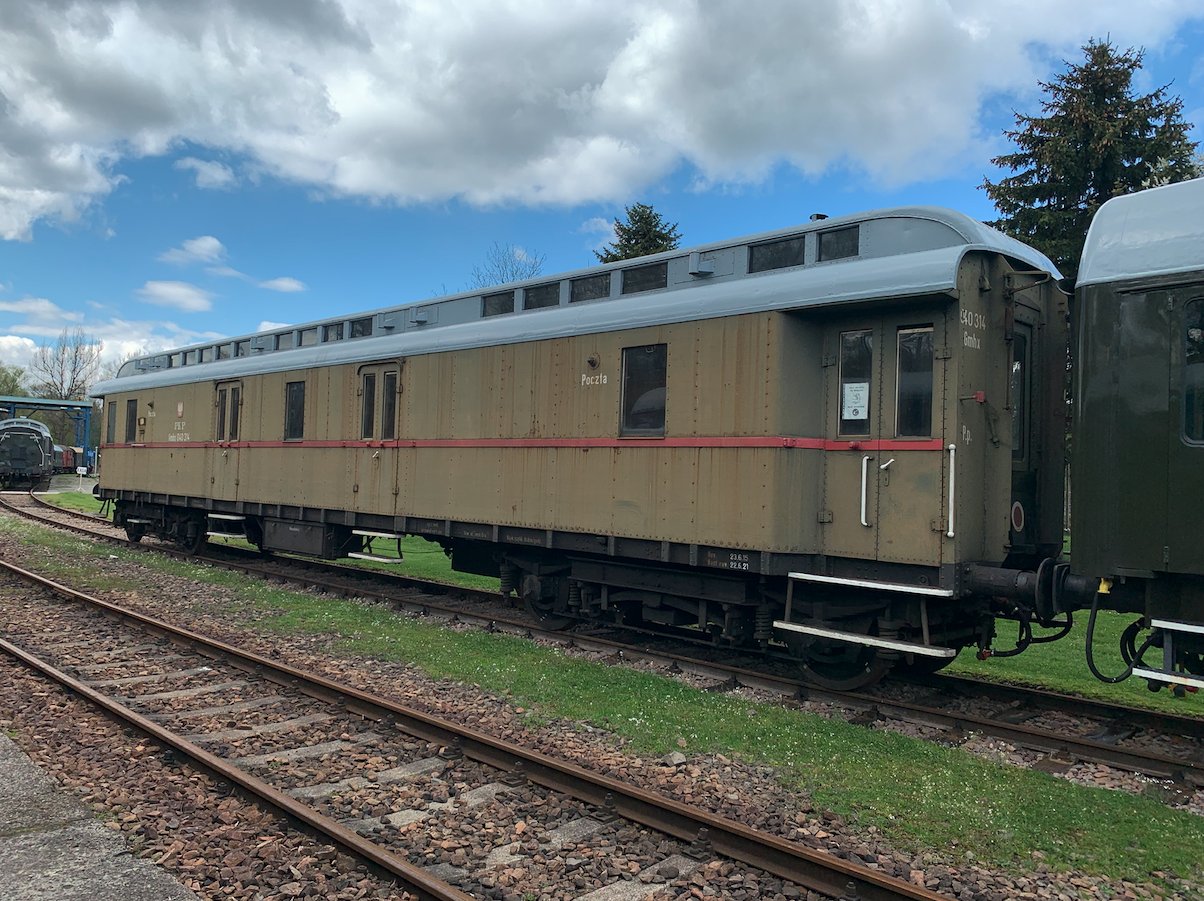
Night train Kraków Główny - Hrubieszów.
In the 1960s, the Krakow Główny - Hrubieszów night train was popular. Distance 378 km. This train was used mainly by travelers who had their relatives in the former Polish Borderlands. The train departed from the Kraków Główny station at around 20:00. At the same time, the train was leaving the Hrubieszów station in the opposite direction. On the section Kraków Główny - Rzeszów the train was fast. He only stopped in: Bochnia, Tarnów, Dębica, Rzeszów and Jarosław. The train continued as a passenger train, stopping at all stations and passenger stops: Lubaczów, Hrebenne, Susiec, Zwierzyniec, Zawada, Mokre, Zamość, Jarosławiec, Miączyn, Koniuchy, Frankomionka, Werbkowice, Hrubieszów Miasto. During the Second Polish Republic it was possible to travel further to Włodzimierz Wołyński, Kowel or Iwanowska. The train reached Hrubieszów before 07:00, so the journey lasted less than 11 hours. The traveling speed was not high, but it was due to the numerous train stations along the route. The train to Tarnobrzeg was overcrowded with passengers. More passengers disembarked at the next stations.
The train was driven by a steam locomotive, usually Ty45 by HCP / Fablok or Ty51 by HCP. These were production locomotives after the Second World War.
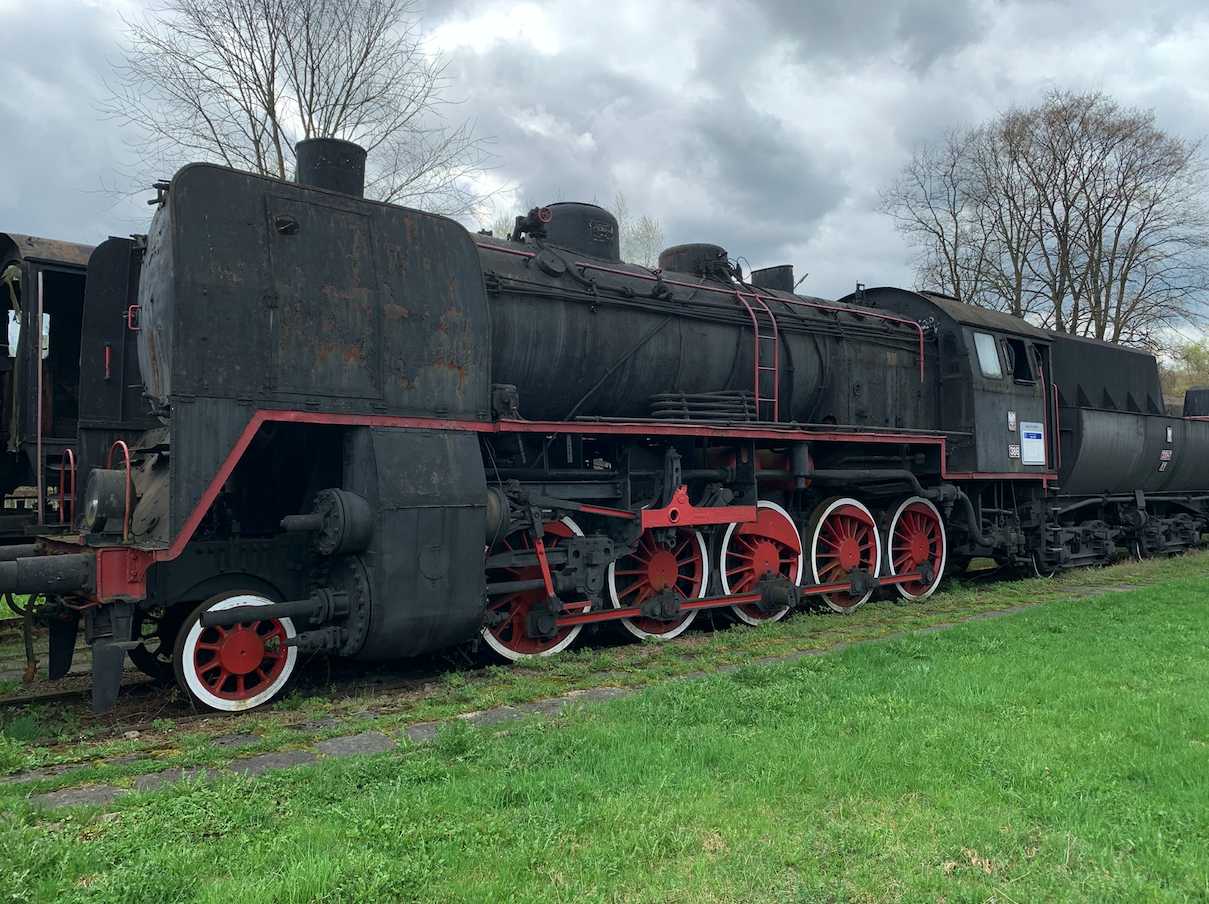
At the beginning of the 70s, the traction that pulled the train changed. These were electric locomotives to Rzeszów: ET-21 or EU07. In Rzeszów, the locomotive was changed to a diesel SU45 or a steam locomotive.
The train consisted of 10 - 12 cars. During Christmas or Easter there were 14 cars. most of the wagons were of post-war production from factories in Poznań and Wrocław. The wagons were heated by steam. During cold winters, a heating wagon was included in the train in order not to limit the power of the steam locomotive too much. The warehouse included a mail car, luggage car and a bar car. The rest of the cars were 1st and 2nd Class.
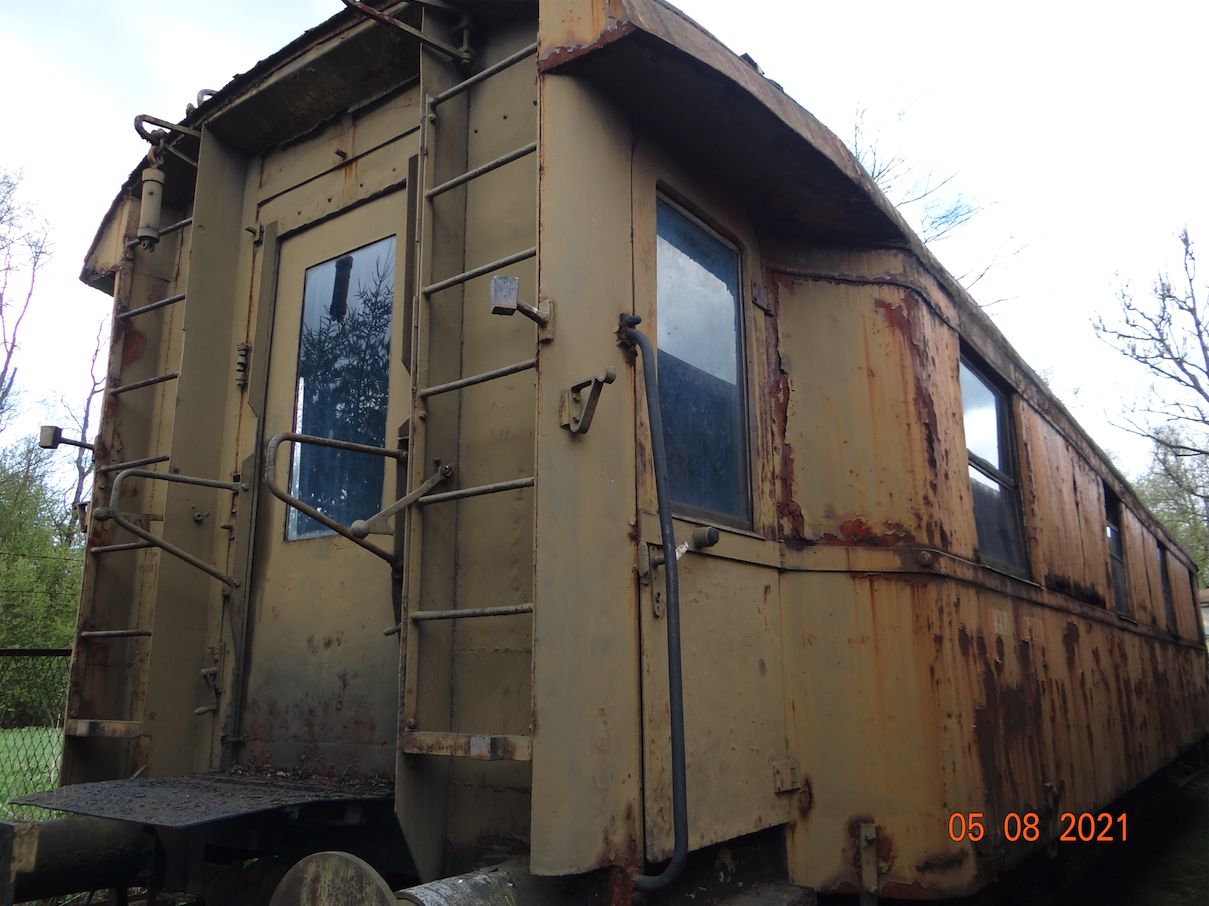
Written by Karol Placha Hetman
